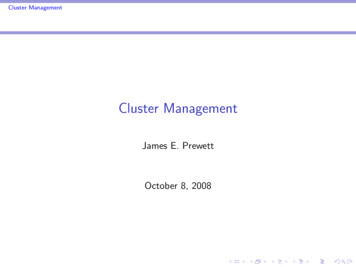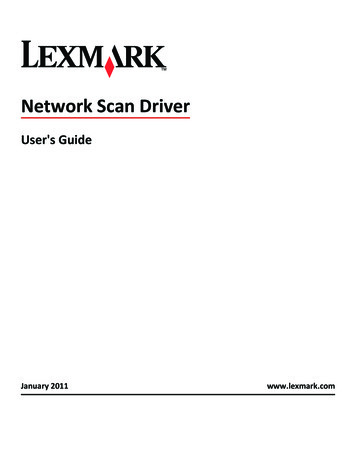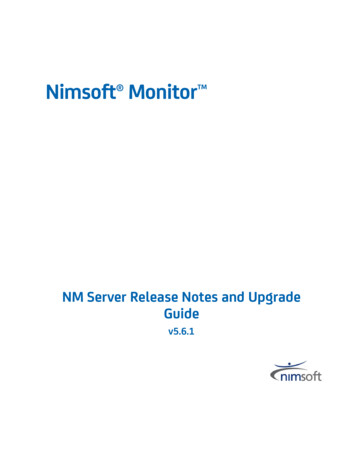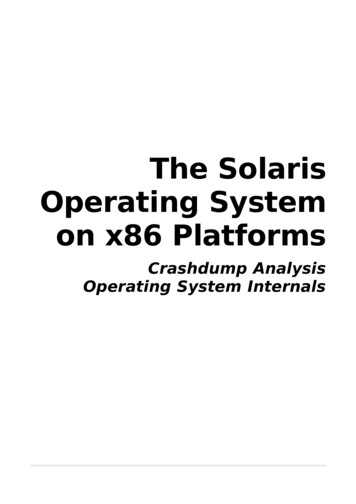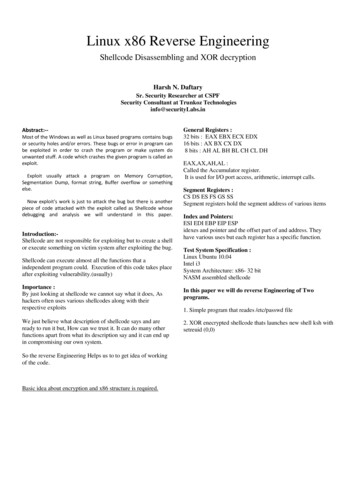
Transcription
Linux x86 Reverse EngineeringShellcode Disassembling and XOR decryptionHarsh N. DaftarySr. Security Researcher at CSPFSecurity Consultant at Trunkoz Technologiesinfo@securityLabs.inAbstract:-Most of the Windows as well as Linux based programs contains bugsor security holes and/or errors. These bugs or error in program canbe exploited in order to crash the program or make system dounwanted stuff. A code which crashes the given program is called anexploit.Exploit usually attack a program on Memory Corruption,Segmentation Dump, format string, Buffer overflow or somethingelse.Now exploit's work is just to attack the bug but there is anotherpiece of code attacked with the exploit called as Shellcode whosedebugging and analysis we will understand in this paper.Introduction:Shellcode are not responsible for exploiting but to create a shellor execute something on victim system after exploiting the bug.Shellcode can execute almost all the functions that aindependent program could. Execution of this code takes placeafter exploiting vulnerability.(usually)Importance :By just looking at shellcode we cannot say what it does, Ashackers often uses various shellcodes along with theirrespective exploitsWe just believe what description of shellcode says and areready to run it but, How can we trust it. It can do many otherfunctions apart from what its description say and it can end upin compromising our own system.So the reverse Engineering Helps us to to get idea of workingof the code.Basic idea about encryption and x86 structure is required.General Registers :32 bits : EAX EBX ECX EDX16 bits : AX BX CX DX8 bits : AH AL BH BL CH CL DHEAX,AX,AH,AL :Called the Accumulator register.It is used for I/O port access, arithmetic, interrupt calls.Segment Registers :CS DS ES FS GS SSSegment registers hold the segment address of various itemsIndex and Pointers:ESI EDI EBP EIP ESPidexes and pointer and the offset part of and address. Theyhave various uses but each register has a specific function.Test System Specification :Linux Ubuntu 10.04Intel i3System Architecture: x86- 32 bitNASM assembled shellcodeIn this paper we will do reverse Engineering of Twoprograms.1. Simple program that reades /etc/passwd file2. XOR enecrypted shellcode thats launches new shell ksh withsetreuid (0,0)
1. Simple program that reads/etc/passwd fileShellcode: ( Download Link given in the end \x51\x53\x89\xe1\xcd\x80"Now we create a simple programt that will execute this codeandCompile it usinggcc –fno-stack-protector -z execstack code.c –o shellcodeIt will compile our code and program should work without anyhindrance.so we create breakpoint at this pointer and run so at pointwe hit our breakpoint that time we disassemble theprogramDebugger Output:0x0804a040 0 :xor eax,eax--- It will xor eax with eax, it is used to make eax register 00x0804a042 2 :0x0804a043 3 :cdqpush edx0x0804a044 4 :push 0x7461632f0x0804a049 9 :push 0x6e69622f0x0804a04e 14 :mov ebx,esp--- Copies the data stored into esp into ebx0x0804a050 16 :push edx0x0804a051 17 :push 0x647773730x0804a056 22 :push 0x61702f2f0x0804a05b 27 :push 0x6374652f0x0804a060 32 :mov ecx,esp0x0804a062 34 :mov al,0xb--- loads AL register with (0xb)hex0x0804a064 36 :push edx0x0804a065 37 :push ecx0x0804a066 38 :push ebx0x0804a067 39 :mov ecx,esp--- copy data stored in esp into ecx register0x0804a069 41 :int 0x80--- Makes a syscall and by interrupt 800x0804a06b 43 :add BYTE PTR [eax],alNow lets change its permission and Execute it in gdbchmod x shellcodeLets load our Program into DebuggerNow we set the disassembling structure to intel.So now we have to stop just before execution so we createbreakpoint at a place where program makes a syscall i.e. ataddress: 0x0804a069Interrupt 80 makes a syscall with syscall number stored in eaxregister,as we can see by code:print /x eax-- eax 11We need to find function that will start at syscall number 11so under x86 structure we open asm/unistd 32.hLooking at our source code file we can find that the name ofpointer in which we stored our shellcode is "code"
This file contains list of functions against their syscall numbersSo at 11th syscall we understand that program is calling"execve"So lets open manual of execveNow we can conclude that shellcode simply reads a file andshows it outputhence It doesn’t harm computer in direct manner2. XOR enecrypted shellcode thats launches new shell kshwith setreuid (0,0)Shellcode :Now lets examine values stored in other 32 bit 2e\x2f\xf5\x9d\xb1\xfc"Now we create a c script that will execute this code andCompile it usinggcc –fno-stackp-protector -z execstack code.c –o shellcodeImportance of this code it to compile our code without anyhindrance. (Just as before)ebx i.e. Second argument contains a hex number whichconverted into string says /bin/catcat is Linux bash command used to read a file3rd argument i.e. ecx register stores a location of file whichwill be read by cat functionso file is 0xbffff3d0:"/etc//passwd"So we conclude that the given piece if shellcode will makeshow output of cat functioni.e. it will read /etc/passwd file and then will exit.Proof Of concept :Lets load our Program into DebuggerLooking at our source code file we can find that the name ofpointer in which we stored our shellcode is "code"so we create breakpoint at this pointer and run so at pointwe hit our breakpoint that time we disassemble theprogram
As we can compare this disassembly output to the previousone, we can understand all the instructions after 0x0804a04dare now decrypted So basically XOR decryption is finished,Now we look at EIP 27 we see that Inturrupt 80 is beingcalled for syscall so we new create our new breakpoint thereJust as Before EAX register contains Syscall NumberEBX and ECX register contains Arguments0x0804a047 7 :0x0804a04a 10 :0x0804a04b 11 :0x0804a04d 13 :xorbincloopjmp 0x7c,(%esi)%esi0x804a047 code 7 0x804a054 code 20 Here this lines of code will Decrypt all the commands till endWith 0x7c and then will jump to 0x804a054So now we create break point just after XOR decryptionfinishes and before it jumps to another memory location forfurther executionSyscall Number is 70And Arguments are 0,0so under x86 structure we open asm/unistd 32.h
So Here 1st argument sets uid and 2nd argument sets gidWhich in our case both are 0Root user has uid and gid 0Means the program here is trying to get the root accessover system.Now lets create breakpoint where program calls interrupt80 to make a syscallHere again we Have Syscall Number 11 that is execvefunction as we saw that last time.And EBX register contains hex data which we convert intostring so we get /bin/kshSo it means This shellcode is going to first decode it self,then will try to get root access on system and then willopen another shell called kshell located at /bin/ksh withroot accessSo this scripts seems to get root access so we won’t executeitAs it seems malicious that why would a normal process wouldtry to get root accessSo In such a way we can do reverse engineering of compiledprograms in linux and Step by step understand what a programdoes.This method can be implemented by Antivirus company inorder to check encrypted viruses or malicious codes.
Reference :1. Vivek ramchandran’s assembly languagetutorial2. J prassanna and Hiren Shah for providingresearch platformShellcodes :1. e-809.php2. e-571.phpTHANK YOU !
ESI EDI EBP EIP ESP idexes and pointer and the offset part of and address. They have various uses but each register has a specific function. Test System Specification : Linux Ubuntu 10.04 Intel i3 System Architecture: x86- 32 bit NASM assembled shellcode In this paper we will do reverse Engineering of Two programs. 1.




